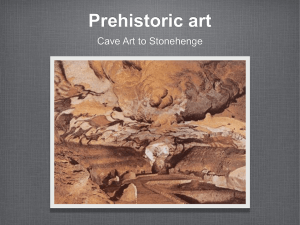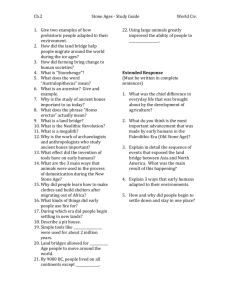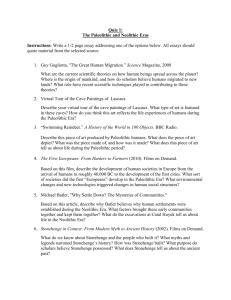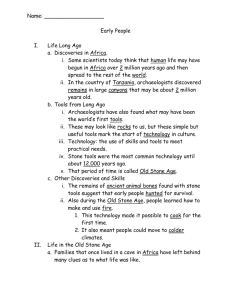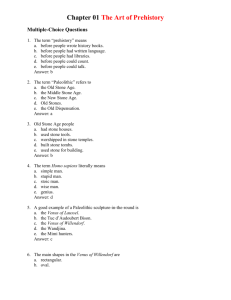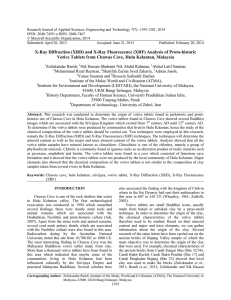PREHISTORY refers to the time before people developed a
advertisement
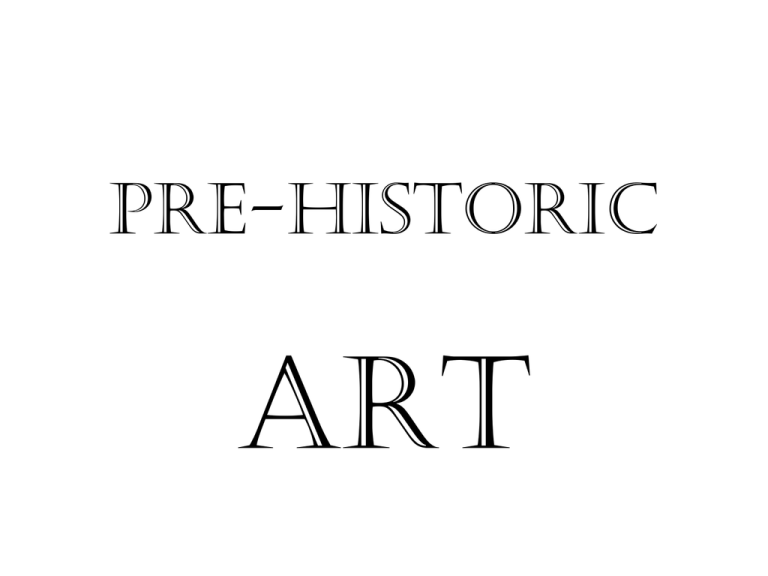
Pre-Historic ART Part I: Paleolithic Art PREHISTORY refers to the time before people developed a writing system. Paleolithic: From the Greek: “Paleo” meaning old “Lithos” meaning stone The historical period believed to have lasted from 30,000BC to about 10,000BC (Old Stone Age=Paleolithic: from 30, 000 B.C to about 10, 000 B.C) Makapansgat, South Africa Ca. 3,000,000 BCE http://www.lascaux.culture.fr/#/fr/02_00.xml Lascaux Cave, France c. 15, 000BC One of the most famous sites of Prehistoric cave paintings. The “Chinese Horse” of Lascaux Twisted perspective: A composite view of many sides in one image Pech Merle, France Bison with turned head ‘Venus’ of Willendorf *Dates from 24,00BC22,000BC . *Discovered in Austria in 1908 *Use of “Venus” term much debated *Purpose unknown Stonehenge, England: c. 2000BC Stonehenge Photos & Video Click Here or copy and paste this link! http://saragant.blogspot.com/search/label/Stonehenge Cromlech: A circle of monoliths, also called a henge. Megalith: A large monument created from huge stone slabs Post and Lintel construction: The earliest form of construction, consisting of massive vertical posts that support crossbeams, or lintels. Part II: Ancient Near East Mesopotamia had its origins in the eastern part of the fertile crescent. The fertile crescent flourished between the Tigris and Euphrates rivers. Civilizations developed in river valleys. Gifted and creative people built houses and agricultural communities around markets then temples. The Sumerians settled here around 4500BC. The Sumerians developed an early form of writing known as cuneiform, (writing with wedge shaped characters) which involves pictures and writing. The Epic of Gilgamesh, one of the first works of literature, was written in cuneiform. The Sumerians developed the first city- states. Cuneiformpicture writing Stylus- writing instrument made out of stone or reed Ziggurat: a stepped mountain made of brick-covered earth Ziggurat at Ur- of ancient Sumeria, 2100BC The priest was the only one in the community that could communicate with the gods. The stepped platform brought the heavens and the gods much closer. Ur was a wealthy citystate known to contain many luxuries, including gold helmets, jewelry and musical instruments. The Standard of Ur is a box of unknown function made of inlayed shell, lapis lazuli (the blue stone) and red limestone. It contains a war side and peace side. Each side is visually divided into three ground lines called registers. Registers are ground lines used for organizing space. Standard of Ur 2400 BC The figures rest on this line. Unlike the cave paintings that had a haphazard organization of space, these are methodically organized on registers. Like cave paintings that used a conceptual rather than optical approach to showing the figures, these figures are all seen in profile, as a way of describing the figure. They are stylized with short, squatty proportions and a large frontal eye (an eye that looks as it was on a face that is facing you, but found on a profile face). Large numbers are shown not as individuals, but by repetition of shapes. Notice the horses and soldiers on the war side. Votive statues from Tel’ Asmar. Votive statues prayed at all times to make up for the fact that it is not humanly possible to pray constantly. Cylindrically shaped statues, they have large wide open eyes and a respectful stance that allows the statue to meet his/her gods in constant, reverent wakefulness. Votive Statue Seated Gudea Bull-headed Lyre 2400 BC Ur cemetary, Iraq Stele with Code of Hammurabi 1792-1750BC (From Babylon) The oldest known written code of Law. The law code dictated penalties for everything from adultery and murder to cutting down a neighbor’s trees. Stele: Inscribed stone pillar Victory Stele of Naram-Sin, 2250 BC Akkadian Period Head of Sargon 2200BC Found in Ninevah Palace complex at Persepolis, founded by Darius the Great 518BC The Ishtar Gate at Babylon Reconstruction Glazed Brick Total Height–47 Ft, Width-32 Ft Neo-Babylonian 7th–6th Centuries BC Dedicator: Nebuchadnezzar II Language: Akkadian Date of Excavation: 1899-1914 Staatliche Museen , Berlin Dept. of the Near East END

